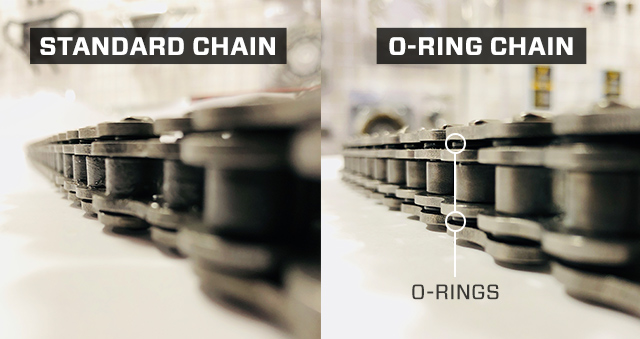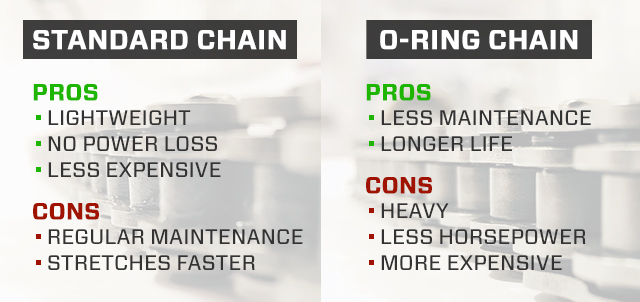
It's an age old question. One that has stymied myriad of professional riders for years serving only to befuddle the weekend warrior and the up-and-coming amateur.
Two styles of chains exist for your riding pleasure: A chain with o-rings and a chain without o-rings commonly known as a standard chain. Standard roller chains have been around forever and also used on bicycles. They remain a favorite, for some, powering dirt bikes and ATVs while the somewhat more technically advanced o-ring version proves a clear winner for others. The o-ring configuration was hardly born yesterday either first hitting the market in 1971.
So, which one is better? And even better, which one should you run?
Manufacturers construct both chains quite similarly, however, you can tell the difference pretty quickly. The o-ring chain looks beefier and feels heavier too. Upon first glance if you had to choose one solely based on visual durability the o-ring chain fits the bill. The o-rings, self-lubricating rubber inserts that fit in between the outside link plates and inside roller link plates, seal in lubrication and seal out dirt and debris around the pin and in between the plates. The added o-rings along with requiring linger pins bulks up the overall chain. Check out the difference below:
Ask any three riders and expect three different answers. One uses only o-ring, another uses only standard and the third uses standard for racing and switches to o-ring for off-road. Each offers benefits over the other and the type of riding, how often you ride and your willingness to invest all plays a part in choosing o-ring versus standard.
Though the plates and rollers remain the same size from a standard to an o-ring chain the longer pin and addition of the o-rings indeed gives an o-ring chain a strength advantage but it also adds some hefty weight and for those racing Motocross every pound counts. Some say the heavier o-ring chain also robs horsepower others say the difference is negligible and you might not even feel it especially on larger bore engines.
The bigger difference between the two chains comes with cost, longevity and maintenance. Those rubber o-rings contain factory-added grease allowing for the continual lubrication of the chain. Of course, the lube eventually dissipates and requires added lubrication but generally offers a longer lasting coating preventing premature wear as you power through mud, sand and water which helps explain why the off-road crowd prefers the o-ring chain.
O-ring chains also stretch less and last far longer than the standard chain. Finally, expect to pay two to three times as much for an o-ring chain compared to the standard.
Casual riders and racers more often prefer a standard chain most notably because of cost but also the weight savings. Spraying the chain down with lubrication between 20 minute Motos hardly constitutes a hassle. Casual riders also don't generally ride as hard thus can stretch the life out without stretching the chain much longer than off-road junkies and hardcore racers.
Overall maintenance is the same for both chains, cleaning and lubricating after a ride, and when replaced so go the sprockets. Thus another cost factor to assume when deciding between the more costly but longer lasting o-ring chain verses the cheaper but less tough standard chain.
So how do I clean it? What if it breaks? How do I install a chain? Find the answers to these questions and more:










